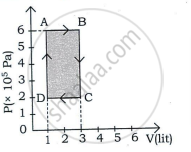Advertisements
Advertisements
प्रश्न
Explain work done during a thermodynamic process.
उत्तर
- Consider the system is initially at state A with its pressure is pi and volume is Vi. Let the state be indicated as coordinates (Vi, pi). It can attain the final state (Vf, pf) along different possible paths as shown in the p-V diagram below.
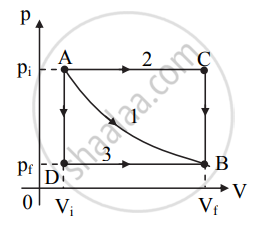
Different ways to change a system - Consider a system that changes its state from initial state A to final state B via path 1 as shown in the figure.
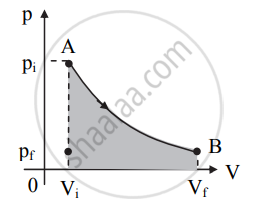
Pressure and volume both change
a. When the system changes itself from A to B, both its pressure and volume change. The pressure decreases while volume increases.
b. The work done by the system is given by the area under the curve. It is positive when the volume increases (as shown in the figure) or negative when the volume decreases. - Consider the system changes its state from A to B via path 2 as shown in figure (a).
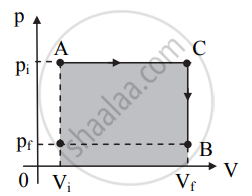
Figure (a)
a. In this case, the volume increases to Vi from point A up to point C at the constant pressure pi.
b. After point C, the pressure of the system decreases to pf at constant volume as shown in figure (a).
c. The system thus, reaches its final state B with co-ordinates (Vf, pf). Work done in this process is represented by the shaded area under the curve in figure (a). - Consider the system changes its state from A to B via path 3 as shown in figure (b).
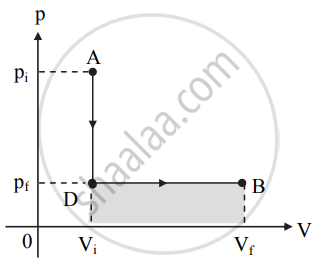
Figure (b)
a. In this case, the pressure decreases from pi to pf at constant volume Vi along the path AD.
b. After point D, the volume of the system increases to Vf at constant pressure pf as shown in figure (b). c. Work done in this process is represented by the shaded area under the curve in figure (b). - From figures (a) and (b) we can conclude that the work done is more when the system follows path ACB than the work done by the system along the path ADB.
Thus, the work done by a system in a thermodynamic process depends not only on the initial and the final states but also on the intermediate states, i.e., on the paths along which the change takes place.
APPEARS IN
संबंधित प्रश्न
Explain why The climate of a harbour town is more temperate than that of a town in a desert at the same latitude.
For work done to be reversible, the process should be ______
Heating a gas in a constant volume container is an example of which process?
Draw a p-V diagram of the reversible process.
State the assumptions made for thermodynamic processes.
Explain graphically (i) positive work with varying pressure, (ii) negative work with varying pressure, and (iii) positive work at constant pressure.
Explain thermodynamics of the adiabatic process.
When you exercise in the morning, by considering your body as a thermodynamic system, which of the following is true?
Apply first law for an isothermal process.
Apply first law for an adiabatic process.
Apply first law for an isobaric process.
What is a cyclic process?
Explain in detail the isothermal process.
Derive the work done in an adiabatic process.
Explain the isobaric process and derive the work done in this process.
What are the limitations of the first law of thermodynamics?
For a given ideal gas 6 × 105 J heat energy is supplied and the volume of gas is increased from 4 m3 to 6 m3 at atmospheric pressure. Calculate
- the work done by the gas
- change in internal energy of the gas
- graph this process in PV and TV diagram
A thermodynamic system undergoes cyclic process ABCDA as shown in the figure. The work done by the system is ______

An ideal gas is expanded isothermally from volume V1 to volume V2 and then compressed adiabatically to original volume V1. If the initial pressure is P1, the final pressure is P3 and net work done is W, then ____________.
An ideal gas is made to go from a state A to stale B in the given two different ways (see figure) (i) an isobaric and then an isochoric process and (ii) an isochoric and then an isobaric process. The work done by gas in the two processes are W1 and W2 respectively. Then,

Two identical samples of a gas are allowed to expand (i) isothermally (ii) adiabatically. Work done is ____________.
In an isothermal process, the volume of an ideal gas is halved. One can say that ____________.
An ideal gas is compressed to half its initial volume by means of several processes. Which of the process results in the maximum work done on the gas?
Consider P-V diagram for an ideal gas shown in figure.
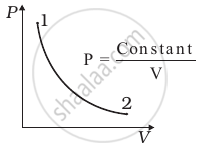
Out of the following diagrams (figure), which represents the T-P diagram?
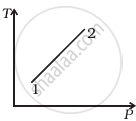 (i) |
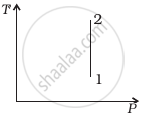 (ii) |
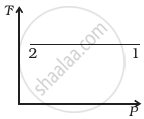 (iii) |
 (iv) |
Explain the thermodynamic process.
An ideal gas is taken through a cyclic process ABCDA as shown in figure. The net work done by the gas during the cycle is ______.
